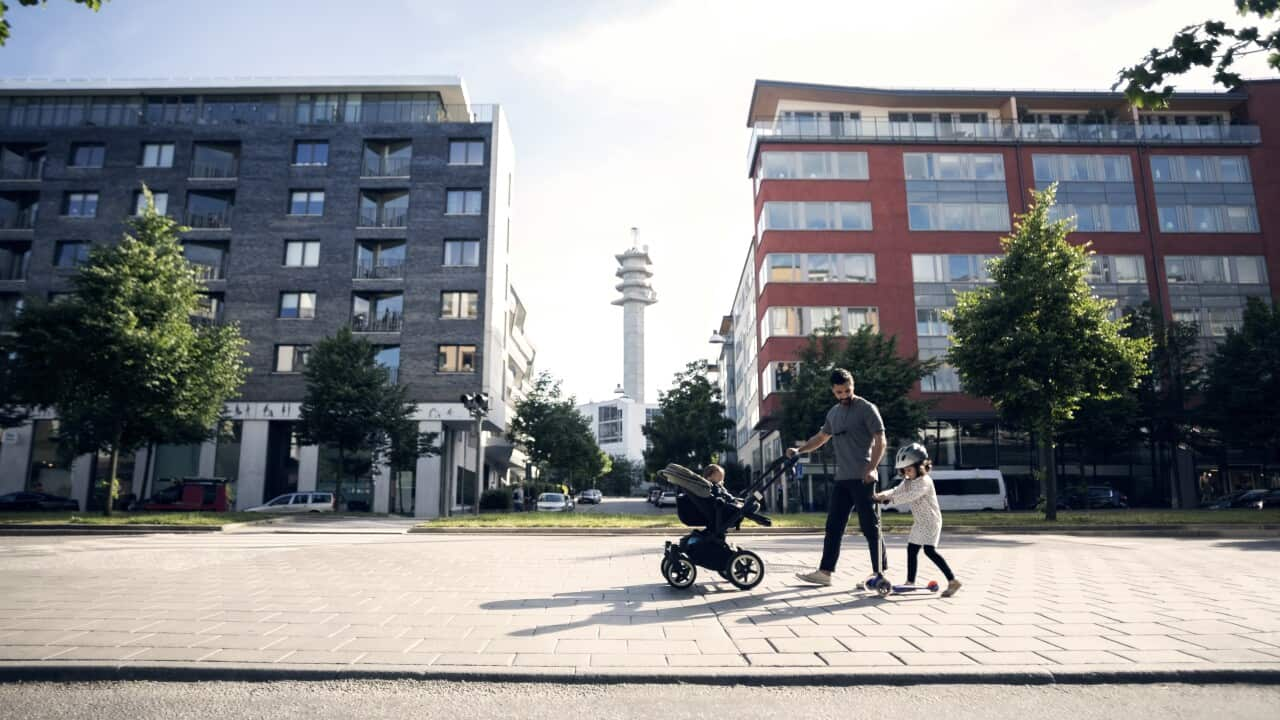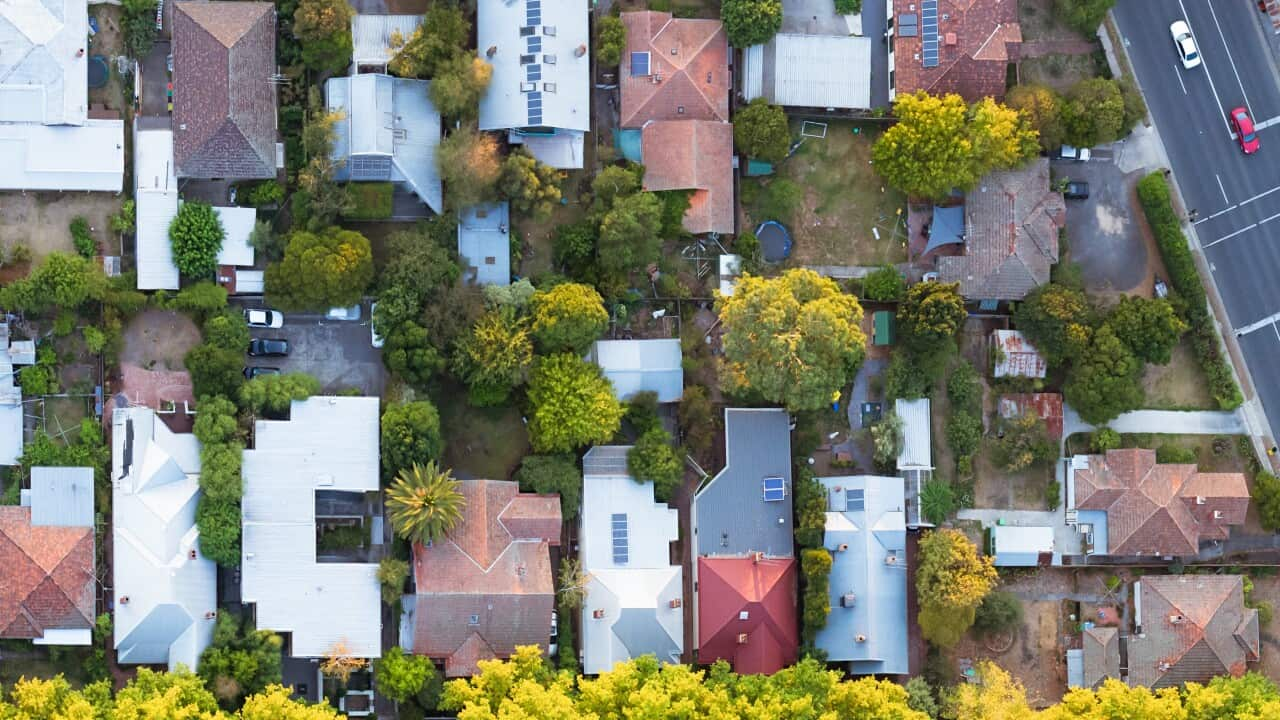When Stacey (not her real name) and her husband returned to Australia after living overseas, her search for a family home took years, even though she was willing to make concessions others weren't.
The 45-year-old, who did not want to be identified, quickly realised that buying a house within a reasonable distance from Sydney's city centre would cost her more than $2 million.
She quickly adjusted her expectations and started considering three-bedroom units instead, but said there were "limited options".
"What is available isn't really geared towards families," she told SBS News.
Stacey, who has a primary-school-aged child, said it was frustrating to find floor plans, especially in newer developments, often didn't feature a reasonably sized dining area or family room to have people over, or for the family to watch TV together.

Experts say many apartments are not designed with family life in mind. Source: Getty / Halfpoint Images
"Lots of apartments seem to be designed with the idea that you'd have urban professionals who probably go out a lot," she said.
Stacey's experience highlights an issue experts say is not being addressed in the rush to fix Australia's housing crisis.
'Family homes aren't being built'
RMIT University urban planning expert Liam Davies said if Australia didn't figure out how to provide more three and four-bedroom properties catering to families in inner and middle city areas, cities would become "very separated".
Davies said developers rarely included three-bedroom units in high-rise apartments, focusing mainly on one or two bedrooms — aimed at investors — because they were more profitable.
"People will pay more per square metre for a two-bedroom apartment than they will for a three-bedroom apartment," he said.
If three-bedroom apartments were offered, they were often designed as luxury products, such as penthouses, so developers could charge more for them. This makes them unaffordable for most Australians.
"I think that's a problem that we've got — family homes aren't being built in apartments in inner and middle suburbs — they're still standalone, separate housing in the outer suburbs and in the growth areas," he said.
Davies said if family homes weren't included in more central large housing developments, prices for the few suitable properties available in these areas would keep rising.
"Middle-income Australians won't be able to raise families in family homes in the inner and middle suburbs. They'll be increasingly forced further out," Davies said.
Middle-income Australians won't be able to raise families in family homes in the inner and middle suburbs. They'll be increasingly forced further out.Liam Davies
Although governments around Australia are trying to find ways to build more homes more quickly, Davies said no one was focusing on ensuring large developments cater to families.
"No one's doing this," he said.
'Houses have become unaffordable'
OH Property Group principal buyers agent Henny Stier helps people buy properties on Sydney's north shore. She says she's seen an increase in demand for three-bedroom properties such as apartments, townhouses, villas and duplexes.
"The problem is that houses have become unaffordable," she said. "So the next best option for people is usually townhouses and villas, and if they can't afford that, they're looking at apartments."
Stier said townhouses were more desirable because they generally had some outdoor space and a "mini-house" feel.
But apartments were also in demand, even if some required owners to pay large strata levies, if they were in desirable locations.
"At the end of the day, even if they have to cough up this huge levy, it's still cheaper than buying a house for a lot of people," Stier said.

Townhouse-style buildings are in demand for those who can't afford to buy a house in a central location. Source: Getty / imamember/iStockphoto
Unless there's a drop in house prices, Stier believes demand for alternative three-bedroom properties will continue to grow.
"I think we need to understand that house prices have gone up so much that we need to find a way to create housing supply for first homebuyers [and] young families," she said.
Three-bedroom units more expensive than houses
The median price for a three-bedroom unit in Sydney and Melbourne is now higher than for a three-bedroom house, according to Domain Group data.
Domain Group chief of research and economics Nicola Powell told SBS News this was because units were often more centrally located.
But prices for three-bedroom units have also risen much faster than for two-bedroom homes.
In the year to March 2024, the price of a three-bedroom unit in Sydney rose by 18 per cent, compared to only 7 per cent for two-bedroom units.

The median cost of a three-bedroom unit increased by 18.1 per cent in Sydney between March 2023 and March 2024. Source: SBS News
But the figures may also capture those who have been priced out of buying a house.
"Houses are [generally] double the price of a unit currently in Sydney," Powell said.

The median cost of a three-bedroom house in Sydney rose by 26.4 per cent between March 2023 and March 2024. Source: SBS News
Three-bedroom units appeal to a wide variety of buyers
Larger units appeal to at least four different groups of buyers, Stier believes, including those priced out of houses, downsizers and others who wanted an extra bedroom to use as a study to work from home.
Stier said couples getting divorced also often bought two apartments using the money from the sale of a house, allowing their children to stay close to schools.
Infrastructure Victoria released a report in March last year that found most people preferred to live in a house but would consider different types of homes in the right circumstances.
About a third of households would swap a house in a new suburb for a three-bedroom townhouse or apartment closer to the city centre if it was cheaper.
But most of these households said they would prefer to live in a townhouse-style building, with fewer than 15 per cent saying they would move to an apartment.
Building the 'missing middle'
Research by the University of NSW’s City Futures Research Centre last year on behalf of the NSW Government Architect found medium-rise apartment buildings were the preferred building type among apartment buyers.
It found buildings of less than 20 apartments were preferred for their larger interior sizes, greater sense of community and smaller strata schemes.
"People looking to purchase, I think, would like to head into a different type of topology — smaller complexes, terraced housing, townhouses. This is the missing middle, which is where the homeownership market is," University of Sydney urbanism expert Laurence Troy told SBS News.
People looking to purchase, I think, would like to head into a different type of topology — smaller complexes, terraced housing, townhouses. This is the missing middle, which is where the homeownership market is.Laurence Troy, University of Sydney
But previous reforms to encourage more of these types of development in NSW have experienced limited success.
Planning law specialist Aaron Gadiel of law firm Mills Oakley said the focus on relatively low-rise developments under previous changes in NSW, meant developers weren't able to offer landowners high enough prices to persuade them to sell.
Gadiel said reforms proposed last year may make it more worthwhile for developers, as it allowed them to build up to six storeys in well-located areas.
A NSW Planning Department spokesperson said the government was working to implement the changes this year.
High-rise living may be a faster solution
Davies said Victoria was already reasonably permissive in terms of its planning rules for townhouses, and these types of properties could be part of the solution, but he believes they offer "limited capacity" to provide more family homes quickly.
He said developers sometimes needed decades to buy enough land to build a medium-sized development.
"If you look at these established areas, the lots are actually quite small, so it's not feasible to build one four-storey building on just one lot, you need to collect a few of them," he said.

It can take decades for developers to buy up enough properties to develop a medium-density apartment block. Source: AAP / Lukas Coch
NSW plans to deliver 377,000 new homes by 2029. Victoria has set a ten-year target of 800,000.
If governments are to meet those targets, Davies thinks they will need to consider converting large areas into residential suburbs, like they have already done with former industrial precincts such as Docklands in Melbourne and Green Square in Sydney.
Delivering family homes as part of these larger developments in inner city areas or as part of large land releases could be a faster way of increasing the number of these properties available, he said.
Government action needed
Davies said stronger planning regulations would likely be required to ensure the internal size of three-bedroom units was "liveable" for families and had a larger living area.
Developers could also be forced to build a certain number of larger dwellings as part of the conditions for building in certain areas, or for land to be rezoned.
Davies said state governments could even start building these types of properties themselves. In places like Singapore and Hong Kong, governments were building most of the housing, and provided apartments suitable for families to support their workers.
"All of the problems we're facing now [are] because we treat housing as a commodity or an asset for wealth creation far more than we do as a product for living," he said.
All of the problems we're facing now [are] because we treat housing as a commodity or an asset for wealth creation far more than we do as a product for living.Liam Davies
A multi-layered issue
Davies acknowledged planning and zoning issues were only part of the problem and said developers would only build when they could make a profit.
Even when a large amount of apartments were built, this often didn't force prices down.
"The moment they start to drop, the developers will hold back supply," Davies said.
He said unless governments found ways to support developers and encourage them to build, Australia was unlikely to solve its housing crisis.
Australian Property Developers Association president Alex Huang is a private developer based in Victoria who has overseen the construction of mid-sized developments.
He said it didn't always make sense to developers to offer a lot of three-bedroom units as demand was sometimes not as high as for two or one-bedroom.

Many high-rise apartment blocks don't offer affordable three-bedrooom units for sale. Credit: Bernard Hermant/Unsplash
Costs for construction materials have remained high since the COVID-19 pandemic. There is also a lack of skilled labour due to an ageing workforce and competition for workers with other large public projects.
Financing challenges can also make it hard to get projects started because banks or other lenders often require a certain level of pre-sales.
"This is a multi-layered issue," Huang said.
He believes new technology could help, pointing to countries like the United States, Germany and Japan, where many homes are built using prefab and modular technologies, making it faster and more cost-effective.
Are Australians ready to embrace apartment living?
Changing planning rules will reduce the time and money developers spend getting projects approved, but Huang doesn't know whether Australians are ready for European-style cities with five or six-storey buildings, like Paris or Barcelona.
"It's still the Australian dream for people to own their own piece of land and have their own backyard," he said.
It's still the Australian dream for people to own their own piece of land and have their own backyard.Alex Huang, Australian Property Development Association president
Davies agreed it's unclear whether there was strong demand for larger apartments but said forcing developers to provide them would help test the market and get people interested in them as an option.
Stacey eventually bought an older-style apartment in Sydney's lower north shore, which is technically a two-bedroom but has a third space they use as a study and retreat for her child.
"It's certainly the case that things in Sydney that were built prior to 2000 had better floor plans, they were just bigger and more solid," she said.
She would have been happy to consider an apartment in a high-rise building but said strata fees were also prohibitive.
While Australians have traditionally considered apartments a short-term option and "stepping stone" to buying a house, especially if they have a family, Stacey believes this needs to change.
"With the costs [of] the property market, I think that needs to be rethought because it actually isn't going to be a stepping stone for people anymore."














